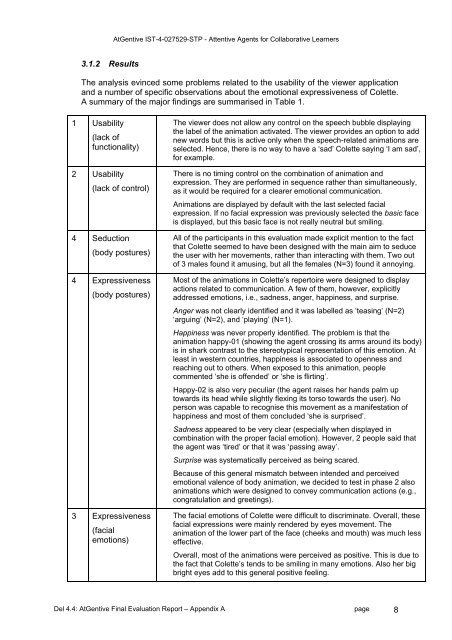Deliverable 4.4 - INSEAD CALT
Deliverable 4.4 - INSEAD CALT
Deliverable 4.4 - INSEAD CALT
You also want an ePaper? Increase the reach of your titles
YUMPU automatically turns print PDFs into web optimized ePapers that Google loves.
AtGentive IST-4-027529-STP - Attentive Agents for Collaborative Learners3.1.2 ResultsThe analysis evinced some problems related to the usability of the viewer applicationand a number of specific observations about the emotional expressiveness of Colette.A summary of the major findings are summarised in Table 1.1 Usability(lack offunctionality)2 Usability(lack of control)4 Seduction(body postures)4 Expressiveness(body postures)3 Expressiveness(facialemotions)The viewer does not allow any control on the speech bubble displayingthe label of the animation activated. The viewer provides an option to addnew words but this is active only when the speech-related animations areselected. Hence, there is no way to have a ‘sad’ Colette saying ‘I am sad’,for example.There is no timing control on the combination of animation andexpression. They are performed in sequence rather than simultaneously,as it would be required for a clearer emotional communication.Animations are displayed by default with the last selected facialexpression. If no facial expression was previously selected the basic faceis displayed, but this basic face is not really neutral but smiling.All of the participants in this evaluation made explicit mention to the factthat Colette seemed to have been designed with the main aim to seducethe user with her movements, rather than interacting with them. Two outof 3 males found it amusing, but all the females (N=3) found it annoying.Most of the animations in Colette’s repertoire were designed to displayactions related to communication. A few of them, however, explicitlyaddressed emotions, i.e., sadness, anger, happiness, and surprise.Anger was not clearly identified and it was labelled as ‘teasing’ (N=2)‘arguing’ (N=2), and ‘playing’ (N=1).Happiness was never properly identified. The problem is that theanimation happy-01 (showing the agent crossing its arms around its body)is in shark contrast to the stereotypical representation of this emotion. Atleast in western countries, happiness is associated to openness andreaching out to others. When exposed to this animation, peoplecommented ‘she is offended’ or ‘she is flirting’.Happy-02 is also very peculiar (the agent raises her hands palm uptowards its head while slightly flexing its torso towards the user). Noperson was capable to recognise this movement as a manifestation ofhappiness and most of them concluded ‘she is surprised’.Sadness appeared to be very clear (especially when displayed incombination with the proper facial emotion). However, 2 people said thatthe agent was ‘tired’ or that it was ‘passing away’.Surprise was systematically perceived as being scared.Because of this general mismatch between intended and perceivedemotional valence of body animation, we decided to test in phase 2 alsoanimations which were designed to convey communication actions (e.g.,congratulation and greetings).The facial emotions of Colette were difficult to discriminate. Overall, thesefacial expressions were mainly rendered by eyes movement. Theanimation of the lower part of the face (cheeks and mouth) was much lesseffective.Overall, most of the animations were perceived as positive. This is due tothe fact that Colette’s tends to be smiling in many emotions. Also her bigbright eyes add to this general positive feeling.Del <strong>4.4</strong>: AtGentive Final Evaluation Report – Appendix A page 8
















